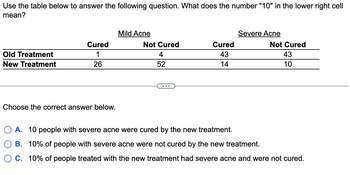
Calculus: Early Transcendentals
8th Edition
ISBN: 9781285741550
Author: James Stewart
Publisher: Cengage Learning
expand_more
expand_more
format_list_bulleted
Question

Transcribed Image Text:### Understanding Treatment Efficacy: Mild vs. Severe Acne Treatments
To answer the question about the following table, which displays the results of different treatments for mild and severe acne, review the details below:
#### Table: Comparison of Treatment Outcomes for Mild and Severe Acne
| | **Mild Acne** | | | **Severe Acne** | |
|----------------|--------------------|-----------|------------|--------------------|------------|
| | **Cured** | **Not Cured** | **Cured** | **Not Cured** |
| **Old Treatment** | 1 | 4 | 43 | 43 |
| **New Treatment** | 26 | 52 | 14 | 10 |
#### Explanation of the Table
- **Old Treatment for Mild Acne:**
- **Cured:** 1 person
- **Not Cured:** 4 people
- **New Treatment for Mild Acne:**
- **Cured:** 26 people
- **Not Cured:** 52 people
- **Old Treatment for Severe Acne:**
- **Cured:** 43 people
- **Not Cured:** 43 people
- **New Treatment for Severe Acne:**
- **Cured:** 14 people
- **Not Cured:** 10 people
#### Question:
What does the number "10" in the lower right cell of the table mean?
- **Answer Choices:**
- **A.** 10 people with severe acne were cured by the new treatment.
- **B.** 10% of people with severe acne were not cured by the new treatment.
- **C.** 10% of people treated with the new treatment had severe acne and were not cured.
To find the correct answer, examine the placement of the number "10" (New Treatment, Severe Acne, Not Cured).
#### Correct Answer:
- **B.** 10% of people with severe acne were not cured by the new treatment.
**Explanation:**
The number "10" represents the individuals with severe acne who were not cured using the new treatment. This does not indicate a percentage but a raw count of the individuals who were not cured. Therefore, the correct interpretation directly from the table data should reference the number of people, not a percentage.
By correctly analyzing the
Expert Solution
This question has been solved!
Explore an expertly crafted, step-by-step solution for a thorough understanding of key concepts.
Step by stepSolved in 2 steps

Knowledge Booster
Similar questions
- You are interested in the development of language in bilinguals. You are able to locate five families in the world with 18-month-old toddlers who are learning both Japanese and Amharic simultaneously. Given that these are the only families that fit this qualification, therefore, these five families are your study population. You test the children to see how many words they can speak in Japanese. The results are listed in the following table: Toddler A P Calculate the mean for this population. B Complete the following table. UO B C Toddler Number of Words (X) 26 48 37 28 с D E D Number of Words in Japanese 26 48 37 28 41 E 41 X-p (x-μ)² Calculate the variance and standard deviation for this population.arrow_forwardIn a memory test, the test subjects are given a large number and are asked to memorize it. Historical records show that 80% of test subjects pass the test. To pass the test, a subject must exactly repeat all the digits in the number after two hours. A random sample of 625 people to take the memory test is going to be chosen. Let p be the proportion of people in the sample who pass the test. Answer the following. (If necessary, consult a list of formulas.) (a) Find the mean of P. 0 (b) Find the standard deviation of p. 0 (c) Compute an approximation for P(P >0.84), which is the probability that more than 84% of the people in the sample pass the test. Round your answer to four decimal places. 0 Xarrow_forwardDetermine whether the given description corresponds to an observational study or an experiment. In a study of 366 women with a particular disease, the subjects were monitored with an EEG while asleep. Does the given description correspond to an observational study or an experiment?arrow_forward
arrow_back_ios
arrow_forward_ios
Recommended textbooks for you
 Calculus: Early TranscendentalsCalculusISBN:9781285741550Author:James StewartPublisher:Cengage Learning
Calculus: Early TranscendentalsCalculusISBN:9781285741550Author:James StewartPublisher:Cengage Learning Thomas' Calculus (14th Edition)CalculusISBN:9780134438986Author:Joel R. Hass, Christopher E. Heil, Maurice D. WeirPublisher:PEARSON
Thomas' Calculus (14th Edition)CalculusISBN:9780134438986Author:Joel R. Hass, Christopher E. Heil, Maurice D. WeirPublisher:PEARSON Calculus: Early Transcendentals (3rd Edition)CalculusISBN:9780134763644Author:William L. Briggs, Lyle Cochran, Bernard Gillett, Eric SchulzPublisher:PEARSON
Calculus: Early Transcendentals (3rd Edition)CalculusISBN:9780134763644Author:William L. Briggs, Lyle Cochran, Bernard Gillett, Eric SchulzPublisher:PEARSON Calculus: Early TranscendentalsCalculusISBN:9781319050740Author:Jon Rogawski, Colin Adams, Robert FranzosaPublisher:W. H. Freeman
Calculus: Early TranscendentalsCalculusISBN:9781319050740Author:Jon Rogawski, Colin Adams, Robert FranzosaPublisher:W. H. Freeman
 Calculus: Early Transcendental FunctionsCalculusISBN:9781337552516Author:Ron Larson, Bruce H. EdwardsPublisher:Cengage Learning
Calculus: Early Transcendental FunctionsCalculusISBN:9781337552516Author:Ron Larson, Bruce H. EdwardsPublisher:Cengage Learning

Calculus: Early Transcendentals
Calculus
ISBN:9781285741550
Author:James Stewart
Publisher:Cengage Learning

Thomas' Calculus (14th Edition)
Calculus
ISBN:9780134438986
Author:Joel R. Hass, Christopher E. Heil, Maurice D. Weir
Publisher:PEARSON

Calculus: Early Transcendentals (3rd Edition)
Calculus
ISBN:9780134763644
Author:William L. Briggs, Lyle Cochran, Bernard Gillett, Eric Schulz
Publisher:PEARSON

Calculus: Early Transcendentals
Calculus
ISBN:9781319050740
Author:Jon Rogawski, Colin Adams, Robert Franzosa
Publisher:W. H. Freeman


Calculus: Early Transcendental Functions
Calculus
ISBN:9781337552516
Author:Ron Larson, Bruce H. Edwards
Publisher:Cengage Learning